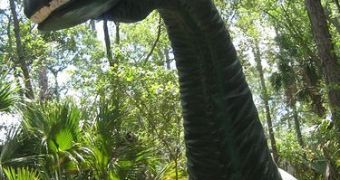The Isle of Wight is one of the richest places on Earth when it comes to dinosaur fossils and a new study revealed that it was fires and floods some 130 million years ago that made this place so “popular”.
When dinosaurs lived and walked the earth, the climate was much warmer than today and on the Isle of Wight, the weather was extremely violent passing from wildfires to extreme floods, that swept everything in their path.
These capricious conditions explain why there are thousand of small dinosaur teeth and bones near huge remains of their gigantic siblings.
Dr Steve Sweetman from the University of Portsmouth worked with Dr Allan Insole from the University of Bristol, and studied the questions regarding this place, that needed answers.
Dr Sweetman explains: “When a fire was rapidly followed by an intense flood a snapshot of life on the Isle of Wight 130 million years ago was taken and preserved for us to see today, making the Isle of Wight one of the most important dinosaur sites in the world.
“Apart from the sheer diversity of dinosaurs found on the island we also have the remains of the animals and plants that lived with them.
“During the Early Cretaceous when dinosaurs roamed, the climate was much warmer than today [and] this was partly to do with the geographical position of the Isle of Wight at the time - the latitude was roughly where Gibraltar is now - but also reflects the extreme greenhouse conditions of that era,” he adds.
“Rainfall occurred all year round but during the summer months, when temperatures soared to between 36 – 40o C, evaporation exceeded rainfall causing drought conditions [and] at these times vegetation became parched leaving it vulnerable to fires caused by lightning strike.
“Occasionally very heavy rain would follow electrical storms and wild fires causing flash floods.
“These swept up all loose objects in their path, swallowed complete dinosaur skeletons and eroded floodplain sediments [and] the more debris and sediment the water collected the thicker and thicker it became until eventually it was like mixed concrete.”
What forms today's plant debris beds of the island is actually this blend of sediments and dinosaur bones collected by the water, deposited in the island's hollows.
They are called plant debris beds as they contain large amounts of scorched and unburned plant fossils of different sizes, that go from large logs to small fragments of leaves.
Because these beds contained rotting plants, all the oxygen was removed by them and the bones fossilized and preserved perfectly.
Dr Sweetman added that “on the Isle of Wight you get a complete muddle of the smallest fossils blended with the biggest, nothing quite like it has been seen anywhere else in the world and the plant debris beds and the mixture of fossils they contain are unique to the island.”
The research is published in the journal Palaeogeography, Palaeoclimatology, Palaeoecology.

 14 DAY TRIAL //
14 DAY TRIAL //